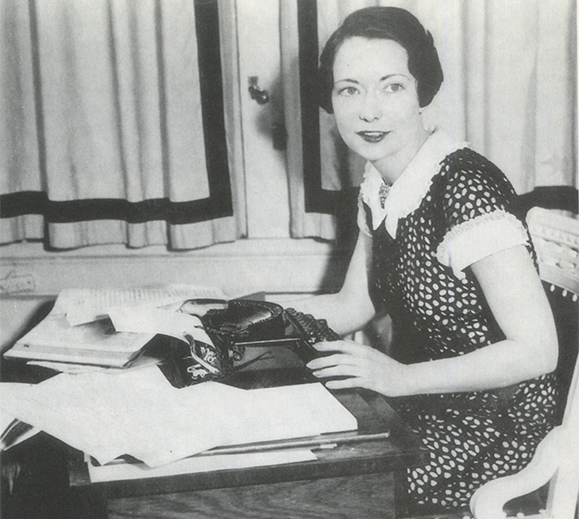Madam, I greet you on the beginning of a great new career.” With these words John Mitchell presented his wife, Margaret, with a second-hand Remington typewriter. Ten years later Margaret Mitchell presented to the world her masterpiece, Gone With the Wind. On November 8, 2000, 100 years after her birth we remember her extraordinary gift.
By the age of 25 Margaret Mitchell had lost her first love, her mother, and married Red Upshaw, an alcoholic, abusive bootlegger. A year she developed crippling arthritis, forcing her to quit her career at the Atlanta Journal and confining her to her bed. What seemed like yet another stroke of bad luck turned into a blessing for readers the whole world over, for it was then that her new husband, Mr. Mitchell, gave her a gift prompting her to give us hers.
Gone With the Wind took Mitchell ten years to write but its roots go deeper, reaching all the way back to Ireland. Mitchell’s great-grandfather Phillip Fitzgerald was born in County Tipperary, immigrating to France and later to Georgia where he married Eleanor McGhan. Of their seven children only three survived, one of whom, Annie, would be a model for the determined and charismatic Scarlett O’Hara.
Annie Fitzgerald married Irish-born John Stephens and bore Margaret’s mother, May Belle, the other great force from which Mitchell drew to create her famous heroine (May Belle founded the more liberal wing of the suffragette movement that became the League of Women Voters). As a girl, May Belle spent summers on the family plantation, “Rural Home.” There she was exposed to the arts as well as the heavily Irish Catholic upbringing of her aunts. She’d pass on this tradition and appreciation to her daughter, Margaret, where it appeared in the novel as the beloved home “Tara.”
Despite Mitchell’s affection for her family’s Irish roots, the Irish are not always portrayed positively in her work. In one instance, the O’Hara family is called nothing but “bog-trotting Irish.” In another, Rhett says he couldn’t care less about “the exotic viands the Irish ate at the siege,” referring to the Irish starved by Cromwell at Drogheda in 1649. Mitchell is portraying an unfortunately too real vision of how the Irish were viewed, especially in the South.
When it comes to her own views on being lrish, one need only look at Gerald O’Hara’s response to the uppity Scarlett’s rejecting his offer of land as part of her dowry. She thinks it is too Irish and beneath their station. Her father is quick to remind her, “And don’t be forgetting that you are half Irish, miss! And to anyone with a drop of Irish blood in them the land they live on is like their mother. ‘Tis ashamed of you I am this minute. I offer you the most beautiful land in the world – saving County Meath in the Old Country – and what do you do? You sniff!”
This pride is evident when Margaret was questioned on the origins of the McGhan family name. She responds, “The McGhans are not Scottish Presbyterians. The name is the most Irish of Irish names and has been a Catholic name as long as the records run.”
Mitchell’s knowledge of her Irish family tree inspired her “great American novel.” As a result she presented a new consciousness of the Irish to millions and they loved it. So much so, the Irish Scarlett O’Hara became a Southern heroine though she said her rosary at night.
Mitchell was no less a heroine, sponsoring undergraduate and medical school education, funding emergency clinics, helping to rebuild the French town of Vimontiers after WWII, and sharing her gift of writing with a program at the Atlanta Federal Penitentiary. She was a full-time volunteer until her death on August 11, 1949.
The Pulitzer Prize-winning book continues to show just how far Irish Americans have come. It still boasts more than a quarter million dollars in sales per year and is second only to the Bible as the best-selling book in history.
Mitchell’s legacy is remembered by the Margaret Mitchell House and Museum in Atlanta. In a style that would make Mitchell proud, the House has hosted such events as “Voices and Verse: The Gaelic Tradition in Contemporary Ireland” and an “Irish Whiskey Fundraiser” to benefit literary programs, as well as displaying memorabilia from the world’s top grossing film. And in the middle of it quietly sits Mitchell’s second-hand Remington typewriter, a gift for which we’d all like to say thank you. ♦


this sit is fuly good im a kid
How lovely to finally reveal and celebrate the Irish-ness of that novel. So bad that aspect of it has been too long ignored, and the novel itself for a while almost “canceled.”
Lest we forget. “Gone With the Wind” was a Pulitzer Prize winning novel. It has been said that it whitewashes Slavery. While Slavery was Evil, which it was, it is very possible that Blacks who worked in domestic service were treated better than those who worked the fields. There may well be depictions that are accurate in the book.